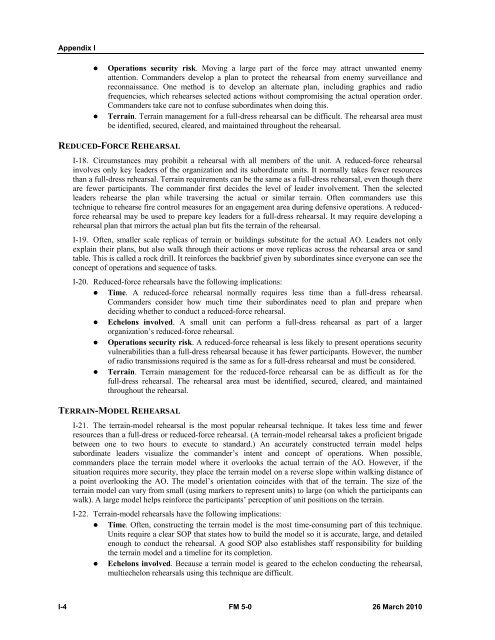FM 5-0, The Operations Process - Federation of American Scientists
FM 5-0, The Operations Process - Federation of American Scientists
FM 5-0, The Operations Process - Federation of American Scientists
Create successful ePaper yourself
Turn your PDF publications into a flip-book with our unique Google optimized e-Paper software.
Appendix I<br />
• <strong>Operations</strong> security risk. Moving a large part <strong>of</strong> the force may attract unwanted enemy<br />
attention. Commanders develop a plan to protect the rehearsal from enemy surveillance and<br />
reconnaissance. One method is to develop an alternate plan, including graphics and radio<br />
frequencies, which rehearses selected actions without compromising the actual operation order.<br />
Commanders take care not to confuse subordinates when doing this.<br />
• Terrain. Terrain management for a full-dress rehearsal can be difficult. <strong>The</strong> rehearsal area must<br />
be identified, secured, cleared, and maintained throughout the rehearsal.<br />
REDUCED-FORCE REHEARSAL<br />
I-18. Circumstances may prohibit a rehearsal with all members <strong>of</strong> the unit. A reduced-force rehearsal<br />
involves only key leaders <strong>of</strong> the organization and its subordinate units. It normally takes fewer resources<br />
than a full-dress rehearsal. Terrain requirements can be the same as a full-dress rehearsal, even though there<br />
are fewer participants. <strong>The</strong> commander first decides the level <strong>of</strong> leader involvement. <strong>The</strong>n the selected<br />
leaders rehearse the plan while traversing the actual or similar terrain. Often commanders use this<br />
technique to rehearse fire control measures for an engagement area during defensive operations. A reducedforce<br />
rehearsal may be used to prepare key leaders for a full-dress rehearsal. It may require developing a<br />
rehearsal plan that mirrors the actual plan but fits the terrain <strong>of</strong> the rehearsal.<br />
I-19. Often, smaller scale replicas <strong>of</strong> terrain or buildings substitute for the actual AO. Leaders not only<br />
explain their plans, but also walk through their actions or move replicas across the rehearsal area or sand<br />
table. This is called a rock drill. It reinforces the backbrief given by subordinates since everyone can see the<br />
concept <strong>of</strong> operations and sequence <strong>of</strong> tasks.<br />
I-20. Reduced-force rehearsals have the following implications:<br />
• Time. A reduced-force rehearsal normally requires less time than a full-dress rehearsal.<br />
Commanders consider how much time their subordinates need to plan and prepare when<br />
deciding whether to conduct a reduced-force rehearsal.<br />
• Echelons involved. A small unit can perform a full-dress rehearsal as part <strong>of</strong> a larger<br />
organization’s reduced-force rehearsal.<br />
• <strong>Operations</strong> security risk. A reduced-force rehearsal is less likely to present operations security<br />
vulnerabilities than a full-dress rehearsal because it has fewer participants. However, the number<br />
<strong>of</strong> radio transmissions required is the same as for a full-dress rehearsal and must be considered.<br />
• Terrain. Terrain management for the reduced-force rehearsal can be as difficult as for the<br />
full-dress rehearsal. <strong>The</strong> rehearsal area must be identified, secured, cleared, and maintained<br />
throughout the rehearsal.<br />
TERRAIN-MODEL REHEARSAL<br />
I-21. <strong>The</strong> terrain-model rehearsal is the most popular rehearsal technique. It takes less time and fewer<br />
resources than a full-dress or reduced-force rehearsal. (A terrain-model rehearsal takes a pr<strong>of</strong>icient brigade<br />
between one to two hours to execute to standard.) An accurately constructed terrain model helps<br />
subordinate leaders visualize the commander’s intent and concept <strong>of</strong> operations. When possible,<br />
commanders place the terrain model where it overlooks the actual terrain <strong>of</strong> the AO. However, if the<br />
situation requires more security, they place the terrain model on a reverse slope within walking distance <strong>of</strong><br />
a point overlooking the AO. <strong>The</strong> model’s orientation coincides with that <strong>of</strong> the terrain. <strong>The</strong> size <strong>of</strong> the<br />
terrain model can vary from small (using markers to represent units) to large (on which the participants can<br />
walk). A large model helps reinforce the participants’ perception <strong>of</strong> unit positions on the terrain.<br />
I-22. Terrain-model rehearsals have the following implications:<br />
• Time. Often, constructing the terrain model is the most time-consuming part <strong>of</strong> this technique.<br />
Units require a clear SOP that states how to build the model so it is accurate, large, and detailed<br />
enough to conduct the rehearsal. A good SOP also establishes staff responsibility for building<br />
the terrain model and a timeline for its completion.<br />
• Echelons involved. Because a terrain model is geared to the echelon conducting the rehearsal,<br />
multiechelon rehearsals using this technique are difficult.<br />
I-4 <strong>FM</strong> 5-0 26 March 2010















